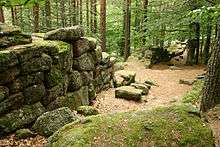Mont Sainte-Odile
_jm3809.jpg)


Mont Sainte-Odile (German: Odilienberg or Ottilienberg; called Allitona in the 8th century) is a 760-metre-high peak in the Vosges Mountains in Alsace in France, immediately west of Barr. The mountain is named after Saint Odile. It has a monastery/convent at its top called the Hohenburg Abbey, and is notable also for its stone fortifications called "the Pagan Wall." In 1992, it was the site of an Airbus crash.
History
The mountain and its surroundings contain evidence of Celtic settlements. The mountain enters recorded history during the Roman times; a fortress was supposedly destroyed by the Vandals in 407.[1] In the second half of the 9th century, when Vikings attacked the Low Countries, which had been recently converted to Christianity and were governed from Utrecht, the Utrecht bishops went into exile and stayed for a while in Mont Sainte-Odile.[2]
At least since the 19th century, its beauty has been celebrated[3] and the mountain, with convent and pagan wall, is often included in tourist guides,[4] incl. Baedeker's.[5]
Hohenburg Abbey
The convent is said to have been founded by Adalrich, Duke of Alsace, in honor of his daughter, Saint Odile, about the end of the 7th century, and it is certain that it existed at the time of Charlemagne. Destroyed during the Middle Ages, it was rebuilt by Premonstratensians at the beginning of the 17th century. It was acquired later by the bishop of Strasbourg, who restored the building and the adjoining church in 1853.
A famous manuscript, the Hortus Deliciarum, was compiled in the convent.
The Pagan Wall
The Pagan Wall (German: Heidenmauer, French: Mur païen) is a huge construction about 10 kilometres (6.2 mi) long which encircles Mont Sainte Odile. It is composed of about 300,000 blocks, between 1.6 metres (5 ft 3 in) and 1.8 metres (5 ft 11 in) wide and up to 3 metres (9.8 ft) high. The origins and date of the wall are still disputed, with some claiming that it is a 3,000-year-old druid construction and more recent research suggesting that it dates from the 7th century AD, about the time that the convent was built. The designation "Pagan" is attributed to Pope Leo IX.
Airbus crash
At 7:20 pm on 20 January 1992, Air Inter Flight 148, an Airbus A320, crashed on a ridge near Mont Sainte-Odile. There were 87 casualties and 9 survivors.
In art and literature
A 2000 poem, "Return to St. Odilienberg, Easter 2000," by the American poet Claire Nicholas White, is inspired by the abbey.[6]
In 2008, local author, Thierry Burkard published an adventure story entitled "Odilia Codex" in French. https://www.amazon.com/Odilia-Codex/dp/2842081811/ref=cm_rdp_product
See also
References
- ↑ Lee, Katharine (1883). In the Alsatian Mountains: A Narrative of a Tour in the Vosges. London: Richard Bentley. pp. 149–50.
- ↑ "Utrecht," in Jeep, John M. (2001). Medieval Germany: An Encyclopedia. Routledge. p. 775. ISBN 978-0-8240-7644-3.
- ↑ Lee, Katharine (1883). In the Alsatian Mountains: A Narrative of a Tour in the Vosges. London: Richard Bentley. pp. 154–56.
- ↑ Ardouin-Dumazet, Victor Eugène (1907). Voyage en France. Berger-Levrault, 1907. pp. 191–92.
- ↑ The Rhine, including the Black Forest & the Vosges: handbook for travellers. Karl Baedeker. 1911. p. 511.
- ↑ Creeley, Robert; David Lehmann (2002). The Best American Poetry 2002. Charles Scribner's Sons. pp. 176–223. ISBN 978-0-7432-0385-2.
- Forrer, Robert (1899). Der Odilienberg: Seine vorgeschichtlichen Denkmäler und mittelalterlichen Baureste, seine Geschichte und seine Legenden. K.J. Trübner.
 This article incorporates text from a publication now in the public domain: Chisholm, Hugh, ed. (1911). "Odilienberg". Encyclopædia Britannica (11th ed.). Cambridge University Press.
This article incorporates text from a publication now in the public domain: Chisholm, Hugh, ed. (1911). "Odilienberg". Encyclopædia Britannica (11th ed.). Cambridge University Press.
External links
| Wikimedia Commons has media related to Mont Sainte-Odile. |
Coordinates: 48°26′N 7°24′E / 48.433°N 7.400°E